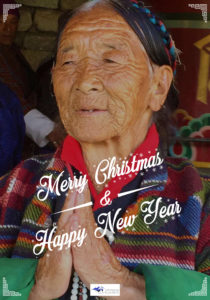The country where the pursuit of happiness is a national, economic goal
Thimphu, Bhutan: Given significant levels of dissatisfaction with the performance of politicians in Western democracies, what can we learn from a country that assesses all of its government policies based on how much they contribute to the happiness of its people?
Looking at the stats, Disneyland may have to give up its claim to being The Happiest Place on Earth. Bhutan’s recent Gross National Happiness Index found 91 per cent of its citizens are happy, with almost 50 per cent of people being deeply happy or extensively happy.
Come to the think of it, Disney’s claim to being The Magic Kingdom also gets a run for its money from Bhutan. With its mist-shrouded mountains, ubiquitous monks and universal acceptance of reincarnation, there is a real sense of magic here.
The story of the monarchy rivals any Cinderella, Mulan or Pocahontas tale. A benevolent king devolves his power to a democratically elected parliament. He then resigns early to hand over the role to his handsome son and his glamorous, humble and compassionate princess. Together the family lives in a couple of single-level bungalows in the nation’s capital, Thimphu, having refused overtures from the parliament to build them a grand palace.
Photos of the young king, his queen and their new son adorn most houses and businesses. These are not stiff monarchical portraits, rather they could be snaps from a family album, with the young couple kissing, holding hands or, together with the former king, playing with the young prince.
This is not a place caught in time warp – there has never been anywhere like Bhutan. This is a unique Himalayan kingdom whose borders have never been invaded and who only opened to the world some 40 years ago.
In 1979 the then-king captured the world’s imagination when he said in an interview “we do not believe in gross national product. Gross national happiness is more important”.
This is different to the World Happiness Report a survey of the state of global happiness which ranks 155 countries by their happiness levels, and this year put Norway at the top of the list, with Australia in ninth.
 The Taktsang Monastery in Bhutan. Photo: Steven Berry
The Taktsang Monastery in Bhutan. Photo: Steven Berry
The results of Bhutan’s focus on the happiness of its citizens speak for themselves. Bhutan is one of the top 20 fastest-growing economies in the world (6.5 per cent last year). It was the only country in South Asia to meet all of the UN Millennium Goals. It has a free press, a good education system and there is universal free healthcare.
Not bad for a country that, up until the 1960s, had no national currency, no telephones, no schools, no hospitals, no postal service and no public services.

A daughter of Bhutan. Photo: Scott Woodward
It is the only country in the world that is actually increasing its level of forest cover – 72 per cent, with the constitution enshrining that the level can never drop below 60 per cent.
While it has its share of troubles: high national debt, stubborn youth unemployment and a recent border dispute with China, it does make a claim to being a real-life Shangri-La.
Bhutan sits as a beacon of peace and prosperity in a world that has become increasingly fractured and unpredictable.
Bhutan has no traffic lights and no advertising billboards. Cars are banned from city roads one day each month to reduce carbon emissions. The country absorbs three times as much carbon as it emits. On the food side, the government is close to achieving its goal of becoming the world’s first wholly organic country.
Just celebrating the eighth birthday of its parliament, it is one of the youngest democracies in the world and, according to the Global Peace Index, it has very low levels of corruption.

Spinning a prayer wheel helps accumulate wisdom and good karma in Bhutan. Photo: Nick Abrahams
Buddhist philosophies are at the core of this country. Its national prosperity and security over the centuries is put down to not so much their “external soldiers”, as the army is known, but the power of the “internal army”, being the 12,000-strong Buddhist monk population. While there is a sharp decline in numbers joining religious orders in the West, in Bhutan more people than ever are joining to become monks and nuns.
A core value is the good treatment of all sentient beings, including animals. Stray dogs are everywhere, but unlike mange-riddled street dogs in other developing countries, these dogs are surprisingly fit and healthy, barking not to be menacing but in the hopes of picking up a friendly pat. They used to have a zoo but it was closed down as it was not a natural environment for the animals.

Seventy per cent of Bhutan’s fruit and vegetables is organic and the government target is 100 per cent. Photo: Nick Abrahams
The concept of Gross National Happiness is a major driver of government policy and the GNH Index done in 2010 and most recently in 2015 is a tangible way of measuring success.
The GNH Index is not a simple survey of wellbeing. It is not Pharrell Williams euphoric dancing in the street-style happiness that is being measured. Rather it measures prosperity, using nine domains including the physical and emotional health of its people, the strength of communities and the condition of the natural environment.

Men sit outside a house in downtown Paro, Bhutan. Photo: Nick Abrahams
Bhutan’s 10-year plan states “the GNH Index is a critical evaluation tool for results-based planning … to ensure that development truly contributes to the achievement of GNH”. This has been echoed by the Prime Minister, Tshering Tobgay, including in a TED talk.
According to Tshewang Tandin, the director-general of Bhutan’s Royal Institute of Management, “people need to have certain subsistence needs met first, adequate food, shelter, healthcare and so on. After that, the GNH Index is a way of measuring real wellbeing of people – their true contentment”.

People walk near a billboard of the Chinese military reading “courageous”, in Beijing, last month. Beijing is intensifying its warnings to Indian troops to get out of a contested region high in the Himalayas where China, India and Bhutan meet. Photo: AP
Bhutan sits as a beacon of peace and prosperity in a world that has become increasingly fractured and unpredictable.
But it is not all fairytale. The kingdom has its challenges. Most serious is a recent Chinese road-building project in the Doklam Plateau, an area on the disputed border between Bhutan and China. Given the proximity of the area, India has responded strongly leading to yet another significant dispute between China and the maturing global superpower.
Economically, Bhutan needs to diversify its revenue base from its hydro-electric power exports to India, which have been the engine room of its economic prosperity. The investment in hydro projects has led to national debt levels outside normal International Monetary Funds (IMF) thresholds.
General unemployment is at an enviable 2.5 per cent, down from 36 per cent in 2000, thanks to targeted government policies including skills programs and incentives for small businesses, especially in rural areas. The problem issue is youth unemployment, sitting at 9.6 per cent.
Bhutan is a country of contrasts. From the solemn sight of devout followers, with shoes on their hands for protection as they make kneeling prostrations every step of long pilgrimages, to youths with boy-band haircuts, traditional dress and mobile phones.
“We are doing a staged transition to a modern economy while protecting our culture,” says Dasho Karma, president of the Centre for Bhutan Studies, then noting with a chuckle that his daughters were out that afternoon to see a touring Korean pop band.
The US Declaration of Independence says governments need to protect the inalienable right of humans to live their lives in the “pursuit of happiness”.
Management thinker Peter Drucker said “you can’t manage what you can’t measure”. So perhaps it is incumbent on governments to measure their success in terms of the happiness of their citizens.
Nick Abrahams is a lawyer, author and entrepreneur. He leads the APAC Innovation Practice for Norton Rose Fulbright and is a director of global think-tank The Institute for Economics and Peace. He was in Bhutan for the launch of the institute’s 2017 Global Peace Index.













 The Taktsang Monastery in Bhutan. Photo: Steven Berry
The Taktsang Monastery in Bhutan. Photo: Steven Berry


















